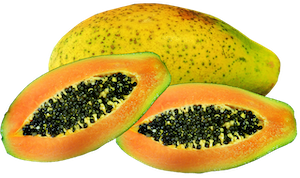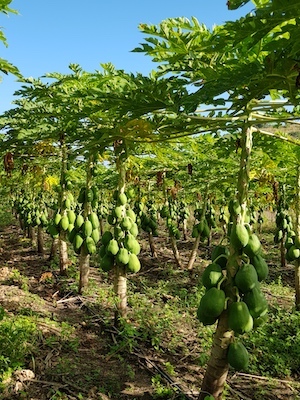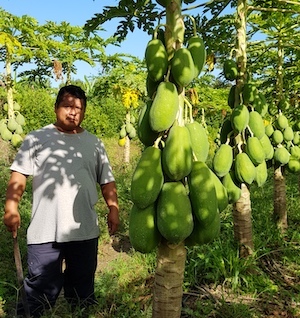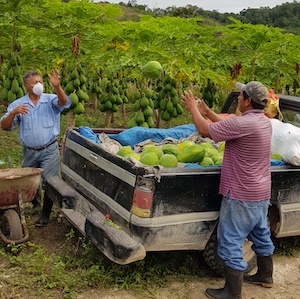Tropical Garden Grow Guide
Where you are the student and the teacher

| Botanic Name |
Carica Papaya |
| Plant Order |
Brassicales |
| Sun Exposure |
Full Sun |
| Soil Ph |
4.5 to 8 |
| Depth to plant |
1/2 inch |
| Maturity |
6 to10 months |
| Height |
up to 30 feet |
| Spacing |
7 to 10 ft |
| Featured plant for the month of January Successful Papaya Growing by Dr. Sophia Clarke -- based on conversations with Cergio Mai (BAHA Plant Health) and Rene Tzib (certified pesticide-free farmer) and the book Fruits of Warm Climates, by J.Morton. As we all know papaya is
delicious, commands a good sale price, and
has many excellent nutritional and
medicinal properties. Growing organically
is much the better for health, but as I
was warned by Cergio Mai of BAHA Plant
Health, “this will be a challenge!” due to
the fact that papaya is susceptible to
many diseases and pests. I can testify to
that as we have found on our farm in Cayo.
So I wanted to find out how we could be
more successful growers of papaya. This article is about Carica
papaya, the specie that is grown in
Belize. In Australia and some parts of the
Caribbean papaya is known as pawpaw but in
his book, Fruits
of
Warm Climates, J. Morton says pawpaw
is better suited to very different, mainly
wild Asimina
triloba Dunal, which belongs to the
family Annonaceae (1). Papaya
is native to both southern Mexico and
neighboring Central American countries
(1). Papaya
Flowers This is
complicated! Papaya plants grow in three
sexes: male, female, and hermaphrodite (in
which flowers contain both male stamens
and female ovaries). But there may even be
plants with both male and female flowers.
Others at certain times of the year
produce male flowers, but at other times,
hermaphrodite flowers. This change of sex
may occur temporarily during high
temperatures. In addition, male or
hermaphrodite plants may change completely
to female plants after being beheaded (1).
The
male plant has flowers which are
clustered, growing at the end of long
branching stalks. The buds are thin and
shaped like an elongated spoon. They have
bright orange anthers. The female flowers
on the other hand, are considerably larger
and fatter, on very short stalks. They are
puffed out by a fat ovary and branching
yellow stigma, where the pollen from a
male or hermaphrodite lands. The
hermaphrodite flower is thinner than the
female flower, having a tubular shape. It
has orange male anthers, and also a
cylindrical ovary, but with no branching
on top. The male produces only pollen,
never fruit; the female produces small,
inedible fruits unless pollinated by wind
or insects. The fruits from female flowers
are round or oval, and thin-walled. The
hermaphrodite
flower, however, is able to
self-pollinate. The fruits from these are
usually cylindrical or pyriform, with a
small seed cavity and a thick wall of firm
flesh which withstands handling well (1).
See what I mean about being complicated? Almost all
commercial papaya orchards contain only
hermaphrodites. BAHA Plant Health advise
planting out only hermaphrodites. Cultivars Two kinds of
papaya are commonly grown. One has sweet
red or orange flesh; the other, yellow
flesh. Large red fleshed “Maradol”,
Maradona”, “Sunrise” and “Caribbean Red”
are commonly grown in Mexico and Belize.
In Orange Walk, the papaya exporters favor
the Tainung variety. (C. Mai,
personal communication, 30.1.22)
Diseases
and Pests Affecting Papaya in Belize. •
Papaya mosaic virus •
Papaya ringspot virus
(PRSV) •
Papaya Meleira virus •
Bunchy top disease
(involves a bacterium belonging to the
genus Rickettsia, and most likely
the vector is the leafhopper Empoasca
papayae ) •
Anthracnose (a group of
fungal diseases) •
Phytophthora (these
resemble fungi but in fact they are not.
They are most often referred to as water
molds.) •
Mealy bugs •
Snails •
White flies •
Leaf hoppers •
Aphids •
Mites Seeds Papaya are
generally grown from seed. You need to
start with certified seeds in order to
grow healthy papaya. There is no hybrid
papaya seed that is 100% hermaphrodite;
generally the range is 50-90%. East West
Seeds in Benque sells hybrid and non-GM
seeds; the agent sells only in bulk (www.eastwestseed.com). Agric-Pric
in
Cayo also sells papaya seeds. A
recommended seed is the Tainung cultivar,
developed in Taiwan, which ranked highest
in extensive trials in Orange Walk. It has
an excellent brix number (sweetness); it
is less hollow than other varieties and
fares well on handling. Certified Tainung
seeds may be available in bulk from the
papaya exporter in Indian Creek, in Orange
Walk. Papaya tolerant to bunchy top
disease have been found and bred, but
production is limited to areas with a low
disease pressure. Also testing well is the
Red Lady variety. (C. Mai, personal
communication, 30.1.22) Saving Your Own Non-GMO
Papaya Seeds Interestingly enough, you can
obtain your own true-to-type seeds from
hermaphrodite plants grown from F1
certified seeds. This is done by (1)
selecting the best trees which are
healthy, (2) carefully covering unopened
flowers with paper bags (stamp collectors
semi-transparent envelopes are ideal), (3)
stapling the ends closed to prevent other
pollen getting in, and (4) marking with a
tag the point where the bud attaches to
the tree, as the bag will burst as the
fruit grows. (www.hawaiihomegrown.net
2014 Rachel Laderman) Harvest the fruit at the color
break stage, and collect the seed from the
fruit. The plants from these seeds should
then grow true to type and be vigorous
because the hermaphrodite flower can self-
pollinate, so the seeds are replicas of
the parent. The seeds should be dried to
moisture levels of 9-12% for long term
storage, as seeds harvested fresh can have
variable germination (3). Germination Firstly remove the gelatinous
layer by rubbing. Place on wet paper or
blanket, cover and leave to germinate. (C.
Mai, personal communication 30.1.22) An
alternative protocol is to soak the seeds
in a container filled with clean water for
48 hours. They should be completely
covered with water. Change the water every
8 hours. After 36 hours, remove the seeds
that float. East West Seeds recommends
that during the last 8 hours of soaking,
you should add 1/4 teaspoon (1.25 ml) of
gibberelic acid per 4 1/4 cups (1 l) of
water. This is a natural product extracted
from the Gibberella
fujikuroi fungus that is found on
rice plants. However, other growers say
adding gibberellic acid is not necessary.
(C. Mai, personal communication, 30.1.22)
It is advised to keep the seed for two
days between two cotton sheets (boiled and
disinfected) while keeping the humidity
constant to avoid dehydration. Sow the seeds in seedling trays
at a depth of 1/2 inch (12.7 mm) against
sun, wind and rain i.e. in protected
structures. Regulate the humidity well to
avoid root rot and fungal attacks. Preparing the Soil Papaya generally do poorly on
land previously planted with papaya, a
result of soil infestation by Pythium
aphanidermatum (a water mold which
causes damping off of seeds and seedlings,
and root rot) and Phytophthora
palmivora (1). Root rot of papaya seedlings,
caused by P.
palmivora, in replant fields can
be controlled with the virgin soil
technique. Virgin soil (soil in which
papaya has never been grown in before)
is placed in planting holes about 12
inches (30.5
cm) in diameter and 4
inches (10.2 cm)deep, with a mound about
1.5 inches (3.8 cm) high. Roots of papaya plants are
protected by the virgin soil during the
susceptible stage, and become resistant
to the pathogen when they extend to the
infested soil. Planting Out Plant out from 6 weeks onwards
(up to 6 months). The site must be free of
volunteer papaya and host plants,
especially in respect of viral diseases.
Raised beds and properly drained land are
ideal for the prevention of Phythophora. It
is important to do soil sampling of your
intended sites prior to planting to
determine the fertility and availability
of nutrients, so that organic inputs can
be customized. Plant 6 seedlings per site, and
then sex the plants at flowering. Due to
being a dominant trait, hermaphrodites are
the most common sex, followed by females
and lastly males. It is best to plant 7
feet (2.2 m) apart, and 12 feet (3.6 m)
between rows; about 3,000 plants per acre
(1200 per hectare). The
best time of year to plant out is from May
onwards excepting December. The
issue
is slow yields in certain months. (C. Mai,
personal communication 25.1.22) Disease and Pest Control
Treatments The treatments should be
Integrated Pest Management (IPM) based.
The following are useful: •
The use of plant barriers:
sunflowers and sugar cane. •
Weed control. •
Colored insect traps;
sticky insect traps. •
Diatomaceous earth,
sprinkled around the plants. Reapply after
rains. •
Neem. •
EM 0.5 (effective
micro-organisms with neem); and EM
Agriculture, a concentrated mother culture
of naturally occurring beneficial
micro-organisms for growing plants. •
For viruses in general:
“roguing”: identifying and clearing out of
diseased and undesirable plants, once a
field is infected. This means that the
control of pests that transmit them is
crucial. •
The cleaning of equipment
and tools. •
For bunchy top disease: in
addition to measures to combat leafhopper
vectors; removal of infected treetops at a
point below where the latex flows freely
on wounding can result in healthy shoots
from the trunk. •
Large net houses (as in
Taiwan) to keep out disease-carrying
non–persistent aphid vectors. The following biological control
agents (with the possible exception of
Metarhizium) are difficult to source in
Belize and in any case, usage should be
guided by an entomologist. • Metarhizium
(a fungus in spore form which is a natural
pesticide against locusts) • Chysopa
spp. (green lacewing insects; their
larvae feed on aphids.) • Timorex
Gold (an organic
fungicide based on a plant extract) • Mealybug
destroyer (Cryptolaemus
montrouzieri, a ladybird species,
which is a biological control against
mealybugs and other scale insects) • Beauveria
bassiana (a fungus which protects
against insect pests) • Parasitic
wasps (C. Mai, personal communication,
30.1.22) Harvesting Studies in Hawaii have shown
that flavor is at its peak when the skin
is 80% colored. However, for shipment, the
first indication of color is permissible.
The fruits must be handled with great care
to avoid scratching and subsequent leaking
of latex which would stain the fruit skin.
Home growers can twist the fruit to break
the stem, but commercial operations prefer
the use of a sharp knife to cut the stem.
The fruits are best packed in single
layers and padded to avoid bruising. Growing Papaya in San Antonio Rene Tzib, pesticide-free farmer
in San Antonio, grows hybrid papaya
successfully from F1 certified seed. (R.
Tzib, personal communication, 4.11.21).
His regime is: • Plant
seedlings out at 3 months, then sex the
plants at flowering at 4 months. Plant out
only 5 male plants out of 100. • Phyton
to protect against fungus: use it as you
plant out; then spray the leaves and soil
every 4 weeks. • EM
Agriculture: apply when planting in a
hole, then again every two weeks. • Sulphate
(or cow or pig manure) and white marl
mixture: use for preparing seedlings
against fungus and ants; spray plant tops
every month. • White
lime: mix with water and put in the hole
when planting; this counteracts ants and
worms. Pruning After fruiting at 6 months, Rene
cuts the big branches, and then the
smaller branches give a second crop. The
plant dies at around 1 year 6 months. Nutritional
Value Papaya is
regarded as a fair source of iron and
calcium; a good source of vitamins A, B;
and an excellent source of vitamin C.
The carotenoid content is low compared
with mango, carrot and tomato. (1) Food Uses Ripe papaya
- Papaya is commonly eaten
ripe, fresh, peeled, seeded and cut into
wedges or chunks. Often it is served
with a wedge of lime to squeeze the
juice over the papaya. Sometimes it is
shaped with a melon baller and served
with other fruit. Firm-ripe papaya can
be seasoned and baked like a vegetable.
Ripe flesh can be made into a sauce for
shortcake or ice cream or swirled
through ice cream before freezing. (1) Papaya
can
also be cooked in a pie, pickled, or
preserved as a jam. (1) Papaya
juice - In Hawaii,
papaya are pureed, and sucrose added to
retard gelling; the puree is then frozen
for use locally, or in mainland USA in
fruit juice blending or for making jam.
(1) Unripe (raw
green) papaya - This is never
eaten raw because of its latex content.
However it is used in Thai and
Vietnamese cooking; in salads it is
peeled, deseeded, boiled until tender,
then chilled. Green papaya is boiled and
served as a vegetable. (1) Papain - The latex of
the papaya plant and its green fruits
contain two proteolytic enzymes, of
which papain is the most potent. This
property makes it especially useful as
meat tenderizer: pieces of green papaya
can be rubbed on meat to make it
palatable. However, papain treated meat
should never be eaten “rare”; it should
be cooked enough to inactivate the
enzyme. Papain has other practical
applications: it is used to clarify
beer, to treat wool and silk before
dyeing, and to de-hair hydes before
tanning, to mention a few. (1). Medicinal
Uses
The handbook
of action Natural
Medicine in the Tropics (4), lists
17 different medicinal uses. This NGO
was founded by Hans-Martin Hirt, a
German pharmacist working in DRC, Congo.
It should be noted that it is not
advisable for pregnant women to eat
papaya seeds. Papaya
Allergy Skin
irritation of papaya harvesters, due to
papaya latex, is well documented. In
sensitized individuals, even the pollen
of papaya flowers can cause severe
respiratory reactions. Following this,
such individuals can display a contact
reaction to any part of the plant, and
to eating papaya or meat tenderized with
papaya. Hybrid
Papaya Seed and Metarhizium Sources in
Belize The Seed
Agent, located at 4 George Price Blvd, Benque
(cell: 636 3678.), sells East
West Maradona F1 seeds. Agro-Pric
(Carlos Herrera) in Cayo, cell: 607
5058, sells hybrid papaya seeds. George
Thiesen, Papaya exporter in Indian
Creek, Orange Walk. Cell: 674 4807. He
will haveTainung seeds available for
sale from March. The Sugar
Industry Research and Development
Institute (SIRDI) sells Metarhizium. (Bz
25 which covers 1 hectare) Procer sells
Phyton. Mile 25
Hummingbird Highway, Stann Creek sells
white marl, white lime and sulphate. References 1. Morton, J.
1987. Papaya. P 336-346. In: Fruits of
Warm Climates. Miami, Fl. Available free
from: https://hort.purdue.edu/newcrop/morton/index.html 2. East West
Seeds (www.eastwestseed.com) 3. Paull, RE.,
Duarte O. 2011. Tropical Fruits volume
1. P. 311. Second edition. UK. MPG Books
Group. 4. Hirt, HM
and Pia, B. 2001. Natural Medicine in
the Tropics. Second edition.
Winnenden. Druckerei Bauer. |



